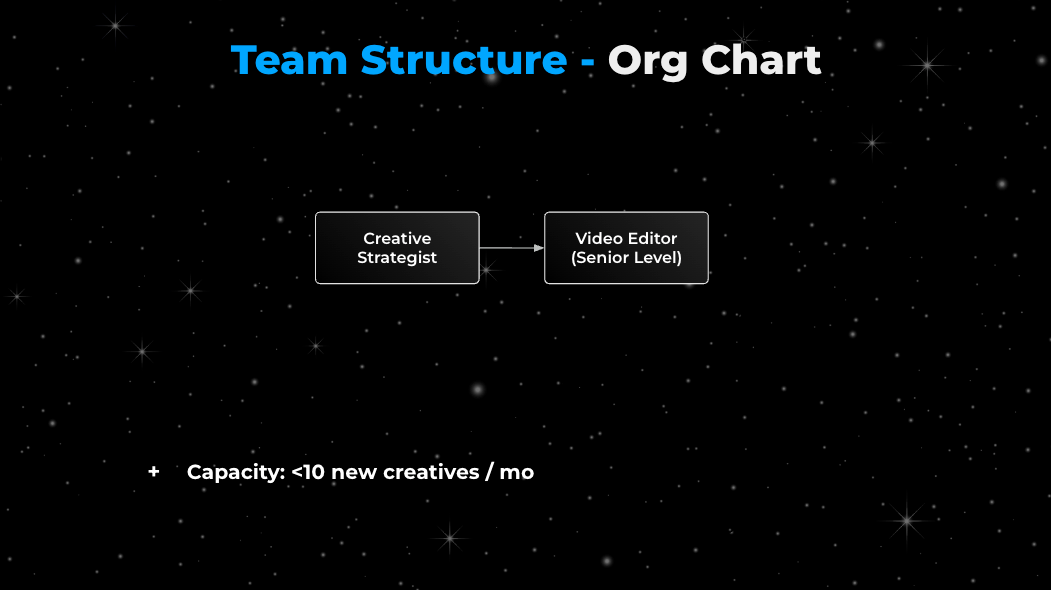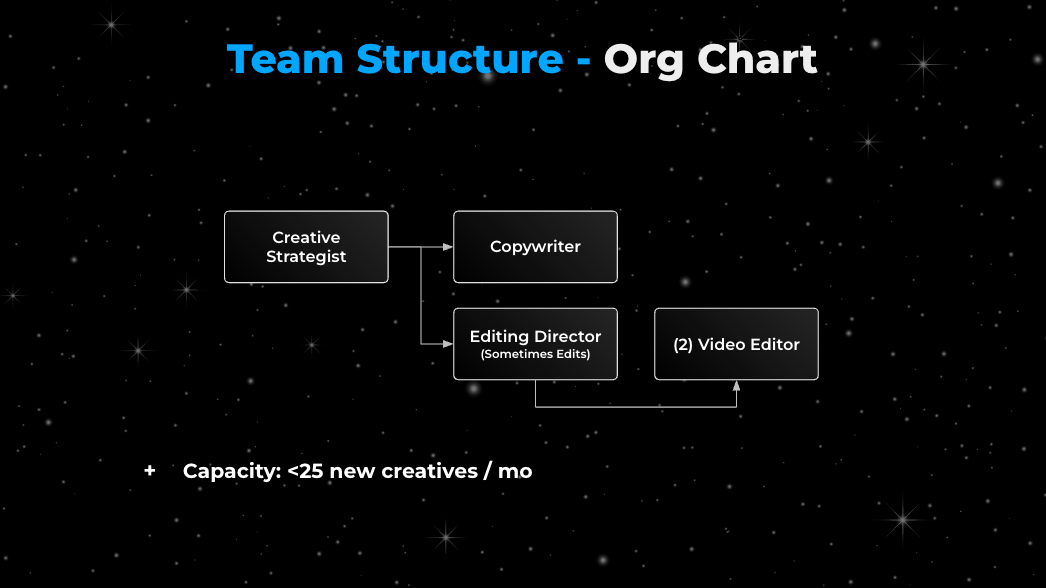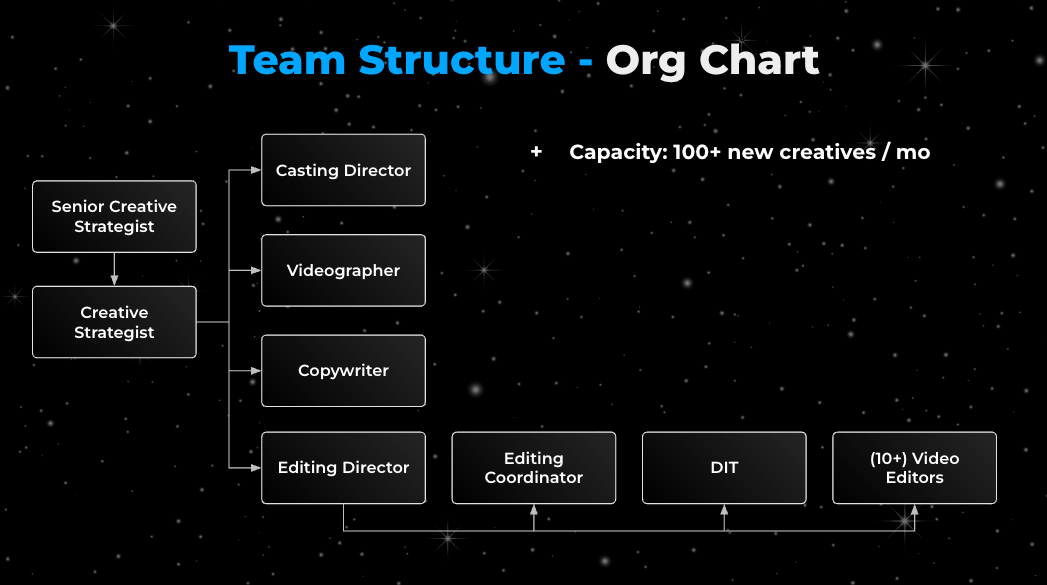How to Build a Video Creative Team That Actually Scales (Without Losing Your Mind)
Complete guide to building video creative teams: structures for 10-200 ads/month. Real data from $100M+ in ad spend.
How to Build a Video Creative Team That Actually Scales (Without Losing Your Mind)
The traditional agency model is broken.
I've seen it firsthand—millions spent, dozens of brands, countless failed team structures. The assembly line approach where your creative vision gets passed from person to person like a game of telephone?
It doesn't work.
By the time your idea reaches the final editor, it looks nothing like what you envisioned. The hook is weak. The pacing is off. The core message is diluted.
And you're left wondering why your 30% hit rate suddenly dropped to 8%.
Here's what nobody tells you about building a performance creative team: structure matters more than talent. You can hire the best videographers, editors, and copywriters in the world—but if your organizational chart is wrong, you'll still produce mediocre ads.
After helping 219+ brands build their creative operations and spending over $100 million on video ads, I've cracked the code on team structure. And today, I'm sharing everything.
The Fatal Flaw in Traditional Creative Teams
Picture this: You have an amazing ad idea. Clear hook. Strong problem framing. Killer offer.
You hand it to your copywriter. They write the script—but they don't quite get the hook right.
Then it goes to your videographer. They shoot it—but the B-roll doesn't match what you envisioned.
Then to your director. They add their "creative touch"—which conflicts with your original vision.
Finally, it reaches your editor. They've never seen your original concept. They're editing based on what they received, not what you intended.
The result? A Frankenstein ad that nobody owns.
This is the assembly line problem. And it's killing your creative output.
The Assembly Line Impact: By The Numbers
According to our data from testing this across 200+ brands:
- Original vision loss: 60-80% by the time content reaches final edit
- Production time: 2-3x longer due to revision cycles
- Hit rate: drops 15-20% compared to visionary-led production
- Team frustration: exponentially higher due to conflicting feedback
The traditional model looks like this:
Creative Strategist → Copywriter → Videographer → Director → Editor
Each handoff is an opportunity for the vision to degrade. It's a game of telephone with your brand's money on the line.
The Visionary Integrator Model
There's a better way. It comes from the Traction EOS framework, and it's revolutionizing how performance creative teams operate.
The concept is simple:
- Visionary = The person with the creative vision
- Integrator = The team executing on that vision
In performance creative, your Creative Strategist is the Visionary. They:
- Develop the concept
- Maintain the vision throughout production
- Make all creative decisions
- Own the final output
Everyone else on the team is an Integrator. They execute the Creative Strategist's vision—they don't add their own interpretation.
This changes everything.
Instead of fighting over creative direction, you have clear ownership. The person who conceived the ad sees it through from concept to final edit. No handoffs. No vision loss. No Frankenstein content.
The Creative Strategist can handle every step themselves (in lean teams) or direct others to execute their vision (in scaling teams). But the key is: one person maintains the vision from start to finish.
Think of it like film directing. Spielberg doesn't hand his script to someone else and hope they interpret it correctly. He directs every element to match his vision.
Your ads deserve the same approach.
Team Structure Comparison Chart
Before diving into each structure, here's a bird's-eye view of when to use each model:
Now let's break down each structure in detail.
Lean Team Structure: 10 Creatives/Month
When to use this: Just starting with video ads, testing the channel, or small brands under $500K/month in revenue.

Team Composition
Capacity & Costs
- Output: ~10 new creatives per month, plus variations
- Total Cost: $8,000-$12,000/month fully loaded
Lean Team Workflow
- Week 1: Creative Strategist develops 3-4 concepts
- Week 2: Scripts written, casting completed, shoot scheduled
- Week 3: Shoot execution, Editor receives footage
- Week 4: Editing, revisions, launch
Pros & Cons
Advantages:
- Very low overhead
- Clear ownership and accountability
- Fast iteration cycles
- Perfect for testing creative systems
Disadvantages:
- Limited capacity (can't exceed 15/month)
- Creative Strategist becomes bottleneck
- No backup if team member leaves
- Can't handle surges in demand
Best for:
- Brands spending $50K-$150K/month on paid social
- Agencies with 1-3 clients
- Testing if the visionary integrator model works for your organization
Real-World Example
When we first started implementing this structure with a supplement brand spending $200K/month on Facebook:
The difference? One person owned the entire vision.
Scaling Team Structure: 25 Creatives/Month
When to use this: You've validated the channel, have consistent creative demand, and need more output without sacrificing quality.

Team Composition
Role Breakdown: How Time Is Allocated
Capacity & Costs
- Output: ~25 new creatives per month, plus variations
- Total Cost: $18,000-$28,000/month fully loaded
Pros & Cons
Advantages:
- Creative Strategist focuses on strategy
- Consistent quality through Editing Director
- Can handle multiple product lines
- Room for specialization
Disadvantages:
- Requires strong Editing Director
- More coordination needed
- Higher fixed costs
- Must maintain consistent demand
Best for:
- Brands spending $200K-$500K/month on paid social
- Agencies with 4-8 clients
- Brands with multiple product lines requiring different creative approaches
Real-World Example
An apparel brand we worked with made this jump when they expanded from one product line to three:
The Editing Director was the key unlock. Instead of the Creative Strategist managing three editors (and becoming a bottleneck), they could focus purely on creative vision.
High-Volume Team Structure: 50+ Creatives/Month
When to use this: You're running a high-performing creative operation and need serious scale while maintaining quality.

Team Composition
The Secret Weapon: Digital Imaging Technician (DIT)
Most teams overlook this role—it's your biggest scaling unlock.
At $50/hour editor cost, that's $1,300/week ($5,200/month) in recovered editor time. The DIT pays for themselves.
Capacity & Costs
- Output: ~50-75 new creatives per month, plus variations and iterations
- Total Cost: $45,000-$70,000/month fully loaded
High-Volume Team Performance Metrics
Pros & Cons
Advantages:
- Serious output capacity
- Can handle multiple brands
- Redundancy built in
- Specialized roles improve efficiency
- Senior/Junior structure enables training
Disadvantages:
- Significant fixed costs ($45K-$70K/mo)
- Requires strong project management
- More complex coordination
- Need consistent demand to justify
- Risk of creative drift across team
- Brands spending $1M+/month on paid social
- Agencies with 10-20 active clients
- Brands running extensive creative testing programs
- Organizations shooting for 40-50% hit rates
Full-Scale Pod: 100+ Creatives/Month
When to use this: You're operating at the highest level—massive ad spend, multiple brands, or agency with numerous clients.

Team Composition
Pod Structure: How It Works
At full scale, you're operating two sub-pods under one Senior Creative Strategist:
Monthly Output Breakdown
Capacity & Costs
- Output: 100-200+ new creatives per month
- Total Cost: $80,000-$140,000/month fully loaded
The Casting Director: Why This Role Matters at Scale
At 100+ creatives/month, talent management becomes a full-time job:
The time savings from this dedicated role more than justify the investment in team efficiency.
Pros & Cons
Advantages:
- Virtually unlimited scaling capacity
- Can handle multiple brands simultaneously
- Deep specialization possible
- Resilient to team changes
- Can support seasonal surges (Q4)
Disadvantages:
- Very high fixed costs ($80K-$140K/mo)
- Requires sophisticated PM systems
- Risk of creative inconsistency
- Only justifiable with massive demand
- Complex coordination challenges
Best for:
- Brands spending $3M+/month on paid social
- Major agencies with 20+ active clients
- Holding companies managing multiple brands
- Seasonal businesses with massive Q4 demands
Real-World Example: Our Internal Operations
We operate this structure across our portfolio of clients:
The Creative Strategist: Your Most Important Hire
Everything rises and falls on this role. Get it wrong, and your entire creative operation crumbles. Get it right, and you'll print winning ads consistently.
According to Harvard Business Review's research on hiring, the cost of a bad hire can be up to 5 times the annual salary. For a Creative Strategist role, that means a hiring mistake could cost you $350K-$750K in lost productivity, training costs, and opportunity cost.
Creative Strategist vs. Common Alternatives
What Makes a Great Creative Strategist: The Scorecard
The 5 Non-Negotiables
Every Creative Strategist must have these core competencies:
1. Data Obsession
2. Direct Response Mastery
Understanding classic direct response principles is non-negotiable. The best Creative Strategists have studied Eugene Schwartz's "Breakthrough Advertising" and Claude Hopkins' "Scientific Advertising"—foundational texts that reveal psychological principles that haven't changed in 70+ years.
3. Production Capability
Minimum requirement: Level 1. Ideal: Level 2+.
4. Systems Thinking
5. High Agency
What's Next?
You've got the complete blueprint:
- Team structures for every stage (10 to 200+ creatives/month)
- Role definitions with clear responsibilities
- Capacity planning triggers and timelines
- Cost-benefit analysis to justify investment
- Actors vs. creators data-backed decision framework
Now you need to decide: Are you ready to build a real creative operation?
Or are you going to keep cobbling together freelancers and hoping for the best?
Because here's the truth: Your competitors are building these teams right now.
The brands winning on paid social aren't doing it with:
- Better products (you might have better products)
- Bigger budgets (you might have more money)
- Lucky algorithms (everyone has the same algorithms)
They're winning with better creative systems.
And creative systems start with team structure.
Your Next Steps
If you're just starting (0-10 creatives/month):
- Hire one excellent Creative Strategist
- Partner them with one Senior Editor
- Document your first 3 winning frameworks
- Scale once you hit 25% hit rate consistently
If you're ready to scale (10-25 creatives/month):
- Add a Copywriter to free up your CS
- Hire an Editing Director (this is critical)
- Add 2-3 more editors under the ED
- Document all processes before adding more people
If you're going high-volume (25-50 creatives/month):
- Bring on a Senior CS to manage the vision
- Add a second CS for execution
- Hire a Videographer and DIT
- Implement sophisticated project management
- Build your actor database to 100+ people
If you're building an empire (50+ creatives/month):
- Structure into pods (2 CS-led teams)
- Hire a Casting Director to manage talent
- Add Editing Coordinator for project flow
- Scale editors to 8-12 people
- Document everything for consistency
The Bottom Line
Stop playing small. Stop settling for 8% hit rates because your team can't execute at volume.
Stop hoping that one more UGC creator will finally "get it."
Stop losing your creative vision in the assembly line.
Build the system. Hire the right roles. Scale intelligently.
The brands printing money on paid social aren't lucky. They're structured.
And now you have the exact blueprint they're using.
Ready to build a creative team that actually scales? Get started with our complete creative operations blueprint and join brands producing 100+ winning ads per month.
Join The Dark Side Of Video Ads

